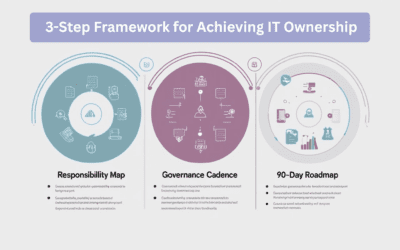Quality over quantity.
With AI, ChatGPT, and Microsoft Copilot, quality over quantity is especially important.
“In a rapidly evolving digital landscape, artificial intelligence (AI) has emerged as a force to be reckoned with. As we stand at the cusp of a new era, it’s clear that AI is no longer a distant dream or a figment of science fiction. It has become an integral part of our daily lives, shaping industries, influencing global economies, and revolutionizing how we think, learn, and interact.”
ChatGPT
Not a bad intro. ChatGPT wrote that in less than a minute, sparked by a simple request to “write me an intro for a blog article on AI.” Unfortunately, this may be how we get content in the future, by feeding ChatGPT a few more questions to dig in, or by simply saying, “Great, thanks, now finish the article for me.” Copy, paste, article, done.
We may be missing the mark and looking at AI and tools such as ChatGPT wrong – we must step back to understand why AI is important and what role it should play in our lives moving forward, especially as AI becomes deeply embedded in the tools we use daily.
Microsoft Copilot enters the chat.
Like any new technology fad and trend, we tend to latch on to it quickly, figure out what it is, and perhaps ignore all the possible implications of its use. Why? Fear of missing out, maybe? It’s hard not to reflect on the digital transformation boom and its looming threat of “join or die.” Sure, some failed but not all. In any case, this is not doomsday preaching on why we shouldn’t use AI – we should. But when and where it makes sense, and without 100% dependency.
AI is here – like it or not. We should embrace it with defined guardrails to ensure it’s used effectively, not abused immensely.
Should I be using AI in my business?
The decision to incorporate AI into your business depends on several factors, such as the nature of your business, your objectives, and the resources you have at your disposal.
Nature of your business
While AI has the potential to revolutionize many industries, not all companies or verticals can benefit equally or extensively from its use. Specific sectors rely on a critical component – emotional intelligence – and necessitate human-to-human interaction. For example, industries such as social work, healthcare and legal services depend on empathy, compassion, and nuanced understanding, which AI cannot fully replicate.
AI could be a supplementary tool in these fields, enhancing efficiency and assisting professionals with specific tasks. For example, AI might help with administrative work, data analysis, or streamlining communication. Ultimately, the successful integration of AI into these industries depends on striking the right balance between leveraging its capabilities for improving while preserving the essential human touch element that defines these professions.
Your business objectives
In the same way we approach digital transformation, or any business endeavour, we begin with a goal and work backward to devise a strategy to achieve it. The journey is as crucial as the destination. Reflect on the days before Google Maps or your preferred GPS app – how did you navigate? A map? Handwritten or printed step-by-step directions? Now that GPS exists in every device, we often overlook the journey and focus solely on the destination, which could be the case for AI. We need first to ask some critical questions:
- What are the goals of implementing AI?
- Is it genuinely integral to the business?
- How can we understand our operations if we become overly reliant on AI?
- Will we still maintain control, or will AI take over?
To help guide your thinking in understanding where AI could play a role:
- Think of AI as an assistant. Consider AI as a colleague for brainstorming but not a resource that handles every responsibility. Striking a balance between harnessing AI’s potential and maintaining human supervision is essential.
- Adopt a “trust but verify” mindset. While AI can offer valuable insights and information, it can also produce misinformation or base its output on outdated data. Always verify AI-generated content to ensure its accuracy and relevance.
- Prioritize output quality over quantity. This focus on quality is vital to maintaining a positive reputation and fostering trust among stakeholders, customers, and employees. Overdependence on AI without sufficient human input can lead to inaccuracies or misrepresentations, which may harm a brand or organization.
“While I strive to provide accurate and reliable information, it’s essential to remember that I am an AI and not a human expert. I may occasionally make mistakes or provide outdated information. It is always a good practice to verify the information I provide with other reputable sources or consult a professional in the relevant field to ensure accuracy and reliability.”
ChatGPT
Resources
According to Robert Half, almost 90% of hiring managers face challenges landing new talent. Further, 50% of workers plan to seek new jobs in the first half of 2023. The risk of people departing our organizations and having to find suitable talent will remain a significant impediment to business growth in 2023. Further, as we stretch our staff, our workloads will naturally increase.
Doing more with less is essential, but we need to pay more attention to the added workload and strain this puts on our employees. Overwork, stress, burden, competing priorities… you name it – it all adds up. And while it’s essential to maintain a proper balance of workload on our employees, we also must be mindful of achieving the business growth we desire without sacrificing customer care and service delivery. It’s a delicate act that AI can help support, especially as we continue to prioritize employee well-being, retention and attraction in today’s competitive markets.
Again, if we think of AI as a resource, it can perfectly complement resourcing requirements in the business. Instead of thinking that AI will replace people, frame AI as a compliment to people.
- What tedious, repetitive tasks exist today that AI can offset?
- What resources are needed to drive the business forward, and where can AI play a role?
- Do you have the internal skillsets to interact with AI (input, validate, assimilate)?
- What AI-related employee enablement and skilling should I be thinking of now?
These three key areas are essential to map where AI fits in your business, how AI aligns with business objectives, and what resources can be impacted, offset, or complimented.
Approach AI cautiously
It would be best to challenge accuracy, context, bias and relevancy in AI output. Also, while output is your end goal, the effort on input is more critical. Context and nuances of how information is fed to an AI model, such as Microsoft’s looming Copilot, direct and influence the output. The output will mirror misguided input, so focus on quality input. This is where the business can help craft how to interact with AI based on what effort is needed, the job role, and which AI source is being used. Policies, playbooks, enablement and education must be prioritized, outlining when, why, how to use, and to what extent the output is consumed, shared, or stored.
“By qualifying my output, you can make better-informed decisions and ensure that the information you receive is reliable and relevant to your needs. It is always a good practice to consult multiple sources and, when appropriate, seek the advice of professionals in the field to make well-rounded decisions.” – ChatGPT
Let’s revisit our Google Maps scenario. Imagine Google Maps was misinformed somehow. You input your destination and blindly (figuratively) follow step-by-step instructions to get to your destination. Finally, according to Google, “you’ve arrived,” but not at the destination you hoped to reach.
Such is the peril of AI for complete dependency. While it’s immensely beneficial for shortcuts and hacks, it’s not a tool to use exclusively or without guidance and control. It’s your Copilot on a journey of continuous improvement, learning, direction, and *temporary* control… treat it with respect, but assume it’s junior to your skills.
Microsoft Copilot
Microsoft announced Copilot across the Microsoft 365 portfolio in March – AI for the Microsoft masses. It’s aptly named. A copilot is “a qualified pilot who assists or relieves the pilot but is not in command.” You remain in control and call the shots, but a qualified assistant is there to help if you need a hand. Microsoft frames Copilot as a resource, not a sole source, and expects its users to control where they need to go. Hence the importance of aligning, setting expectations, and ensuring proper use of Copilot and AI in general.
Microsoft Copilot “combines the power of large language models (LLMs) with your data in the Microsoft Graph and the Microsoft apps to turn your words into the most powerful productivity tool on the planet.”
Microsoft Copilot will exist in two ways:
- Embedded in the Microsoft 365 applications we use every day, and
- Within Business Chat, working across both applications and your data.
Microsoft Copilot will support you by:
- Aiding in Creativity. Think of “writer’s block”, or how to craft that perfect e-mail or get to the point with brevity (“Hey Copilot, shorten this blog post.”)
- Unlocking Productivity. Getting to inbox zero? Quicker. Summarize long-winded e-mails? Check. Daydreaming during TPS report review meetings? Fine, Copilot will deliver key points and takeaways. (“Hey Copilot, are my expenses higher or lower than my golf handicap?”).
- Upleveling Skills. Increase your strengths and build on your weaknesses. Not certain of the financial trends in your Excel spreadsheets? Copilot will paint the picture. Unaware of the latest long-form blog posts Marketing is developing? Copilot will summarize and deliver the key points to ensure team consistency.
Should I be concerned about Microsoft Copilot and my data?
Glad you asked. One of the major concerns around AI is data, specifically, sharing too much of it. Fortunately, Microsoft Copilot is “grounded in your business data,” meaning the LLM is connected to your business data in a “secure, compliant, and privacy-preserving way.” Therefore, responses are generated based on your content and context. Better still, Copilot will inherit your existing Microsoft 365 security measures, policies, and processes, and respect your boundaries, ensuring data will not leak across user groups and Microsoft customers. Microsoft has built Microsoft 365 Copilot with its existing commitments to data security and privacy, grounded in AI principles, Responsible AI Standards, and decades of research. Copilot’s large language models are not trained on customer content or on individual prompts.
How can you benefit the most from Microsoft Copilot?
As Copilot will be embedded within the Microsoft 365 ecosystem, one can naturally assume Copilot will default to your data and services within Microsoft 365. If you are fully immersed in Microsoft 365 already, you’re in a good spot to maximize the benefits of Copilot. If you are not a Microsoft 365 customer or are utilizing Microsoft 365 services in a limited scope, there is an opportunity now to expand your Microsoft 365 footprint in preparation for Microsoft Copilot. We can help with that! FOMO unintended.
Further, as we inch closer to Microsoft Copilot’s release, more technical details will be shared, as well as public releases, to equip our team with the necessary know-how to guide implementation, utilization, and employee enablement.
When will Microsoft Copilot be released?
Microsoft Copilot was officially announced on March 16, 2023; however, an official release date has yet to be provided. A handful of Microsoft customers are currently testing Copilot, so the platform is likely in a production state (or quite close). We expect it to be available, en masse, over the coming year.
How is Microsoft Copilot licensed?
Great question, and we’d rather not fuel the rumour mill. We hope Copilot for Microsoft 365 is included in our preferred subscription, Microsoft 365 Business Premium (included in Workplace Suite). However, due to the wild variability in how OpenAI and ChatGPT is currently licensed, Copilot may be licensed separately, by consumption, or within an entirely different package. Again, as we get closer to release, we expect details around licensing for Copilot, Business Chat, and the slew of other Copilot introductions (including Copilot for Defender, and Copilot for Dynamics 365) to be readily available.
Start planning now
While we are overly optimistic about AI’s benefits to businesses of all sizes, we must begin planning and understanding how AI will impact our business, specifically across people, process, and technology, and what role and priority it will have moving forward. In any business-related conversation, AI will and should have a seat at the table; however, remember, AI should augment, not displace.






0 Comments